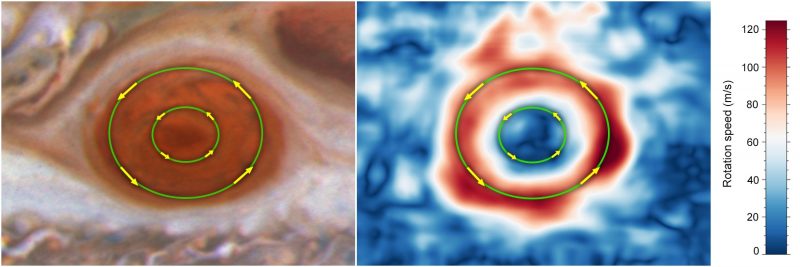Great Red Spot winds speeding up
Since people invented the telescope in the 1600s, eyes have been focused on Jupiter. The earliest sighting of the Great Red Spot, a humongous storm on Jupiter, might have been in 1665. Skywatchers observed the giant swirling storm sporadically between 1831 and 1879. Then regular observations began, and astronomers did their best to monitor it from Earth. Their observations ramped up dramatically in 2009, when the Hubble Space Telescope turned its razor-sharp eye on the Great Red Spot. On September 27, 2021, scientists announced they’ve learned that – from 2009 to 2020 – the winds in the outermost ring of the Great Red Spot are speeding up. They said these studies will let us learn more about Earth’s atmosphere.
The data from the Hubble Space Telescope show that the counterclockwise wind speeds in the outermost region of the Great Red Spot have increased by 8% between 2009 and 2020. Scientists call this zone of the Great Red Spot the high-speed ring, with good reason. Winds now top 400 miles per hour (almost 650 kph) in this zone. Meanwhile, the speed of the winds toward the center of the storm is decreasing.
Michael Wong of the University of California, Berkeley, led the analysis of the winds. As he explained:
When I initially saw the results, I asked ‘Does this make sense?’ No one has ever seen this before.
He continued:
We find that the average wind speed in the Great Red Spot has been slightly increasing over the past decade. We have one example where our analysis of the two-dimensional wind map found abrupt changes in 2017 when there was a major convective storm nearby.
Hubble is Jupiter’s storm tracker
Hubble measured wind speeds that changed about 1.6 mph (2.5 kph) per Earth year. The space telescope can spot features in the Great Red Spot that are as small as 105 miles (177 km) across. Amy Simon of NASA’s Goddard Space Flight Center said:
We’re talking about such a small change that if you didn’t have eleven years of Hubble data, we wouldn’t know it happened. With Hubble we have the precision we need to spot a trend.
Wong used software to track hundreds of vectors of direction and speed in the Great Red Spot. Every time Hubble observed Jupiter, the software took new measurements. Wong said:
It gave me a much more consistent set of velocity measurements. I also ran a battery of statistical tests to confirm if it was justified to call this an increase in wind speed. It is.

A history of change on the Great Red Spot
The Great Red Spot is always changing, not just with wind speeds. Sometimes observers report it paler or darker, and over the past 100 years it’s been shrinking and growing rounder. In the 1800s, scientists said it was three times the size of Earth, while now it is a bit larger than the diameter of Earth.
Researchers can take what they learn at Jupiter and apply it to storm systems seen on other planets, such as Neptune. By comparing storms on different worlds, they can begin to understand what drives these storms and causes them to persist or fade away.
Bottom line: Winds in Jupiter’s Great Red Spot have been speeding up over the past decade, according to data from the Hubble Space Telescope.











